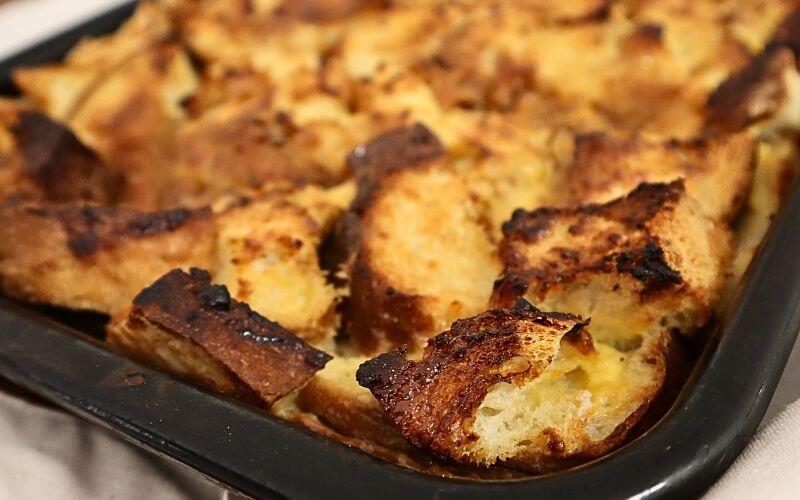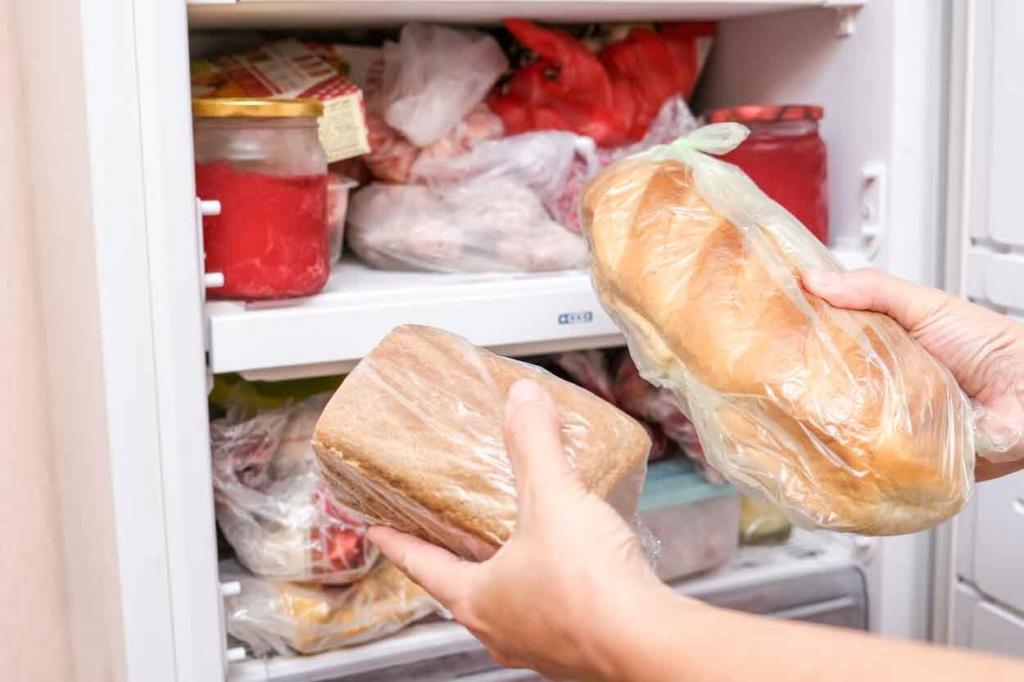A common question among bread enthusiasts is how long does bread last in the fridge. Are you struggling to keep your bread fresh, or have you heard conflicting advice about how best to store bread?
I’ve been baking bread professionally for over ten years, and I’ve tested every method possible to keep bread fresh.
So whether you’re a seasoned baker or have no intention of ever opening a bag of flour, you’ll learn the ins and outs of storing bread in the fridge. We’ll also cover the best practices for maintaining freshness and more.
Whilst not the most clamorous subject I write about, storing bread correctly is crucial to extend its shelf life and preserve its delightful texture and flavour. So let’s get to it!
How to Store Bread in the Fridge

Regarding bread storage, the refrigerator can be a double-edged sword. While cool temperatures slow down the growth of mould, they also accelerate the staling process. To strike a balance, follow these steps:
Wrap it Right: Wrapping bread correctly reduces moisture loss which causes the bread to turn tough and dry.
So use airtight packaging, such as plastic bags or plastic wrap, to create a barrier around your bread and the fridge. The shield this provides protects the bread from the fridge’s dry air.
Avoid the Door: Place the wrapped bread away from the refrigerator’s door. The temperature fluctuates more near the door, leading to condensation inside the bag and promoting mould growth.
How Long Does Bread Last in the Fridge?
To determine how long bread is good for in the fridge, it’s essential to understand that bread lifespan varies.
Depending on the type of bread, how well it’s wrapped and the temperature of the fridge, the shelf-life of bread changes.
On average, commercially baked bread, like sandwich bread, can last around 5 to 7 days in the fridge while maintaining reasonable freshness.
With its heartier texture and fewer preservatives, artisan bread might last for about 3 to 5 days in the refrigerator.
Whole grain and whole wheat bread, known for their higher moisture content, fare better in the fridge due to reduced mould growth.
Remember, these are rough estimates, and the actual duration can vary.
Why does bread go stale?

Understanding the science behind bread staling will help you make the best storage choice.
Although what is defined as bread staling has been regularly debated in scientific circles, three core changes can be agreed on (generally – it’s a hot topic!):
1) Recrystallization of starch molecules
When hydrated starch molecules are heated, they change from a crystallised (solid) state to a gooey-mesh-like structure.
As soon as the starches cool, they reorganize and recrystallize, meaning homemade bread becomes firm and dry after a day or two.
2) Water loss
When the bread is kneaded, starches and gluten proteins capture water in their structures.
Baking causes much of the water to evaporate. However, some water remains, which contributes to a soft crumb texture.
As the fresh bread ages, the water molecules continue to evaporate into the atmosphere. The older the bread, the more dry and dense it will be.
3) Mould multiplies
Mould spores can be found everywhere. As bread ages, its pH value rises from slightly acidic to neutral.
With free water molecules available, stale bread becomes the ideal breeding spot for mould. The spores multiply, producing visible spots or “hairs” on the surface of the loaf.
Does bread go bad in the fridge?
While refrigeration can extend the shelf life of fresh bread, it’s often not the best storage option.
The recrystallisation of starch is accelerated in cool temperatures. Therefore, when bread is stored in the fridge, it turns hard much faster than at room temperature.
If your bread is hard, it can be rejuvenated by toasting or re-baking. See my tips below.
When should bread go in the fridge?
If you’ll consume your bread within a couple of days, there’s no need to refrigerate it. In fact, keeping bread at room temperature will, in most cases, preserve its taste and texture better.
You should only use fridge storage to prevent your bread from becoming mouldy. if you are in a warm and humid environment, mould can develop early, so placing your bread in the fridge could be your best option.
What is the best way for bread to last longer?
To maximize the freshness and extend the life of your bread, you might consider the following tips:
Freezing: If you won’t consume your fresh bread in a few days, consider freezing it. Freezing significantly prolongs bread shelf life with minimal loss to its taste and texture.
Use a Bread Box: Instead of the fridge, consider using a bread box. Bread boxes provide a slightly cool and dry environment with airflow.
In an environment like this, starch recrystallisation is slowed, whilst the onset of mould is delayed as the water released from the bread as it ages can escape.
Store bread dough in the fridge: If you are making homemade bread yourself, instead of trying to keep your bread fresh, divide your dough batch and store the remainder in the fridge!!
As described in does dough go bad in the fridge, dough will stay good in the fridge for a day or two.
Actually, maturing bread dough for an extra day can improve the taste and texture of homemade bread!
How to save stale bread!!

If your bread has turned stale and hard, providing it’s not mouldy, you can most likely get another lunch from it!
Toast it
Revive it by reheating it in the toaster or microwave.
Bake it
Better still, as described in how to revive stale bread, soak the loaf in water and refresh it in the oven!
Make bread pudding
Dry bread is perfect for making bread pudding. All you need to do is make a gorgeous sweet custard to soak the stale bread slices and bake.
Make French toast
If bread pudding is not your thing, perhaps French toast is! Again, the slices are soaked in a sweet custard, but the bread is fried in butter this time. Discover the best bread for French toast.
How to freeze bread

Freezing bread is an excellent method to preserve its freshness for an extended period.
Bread should last 3-4 weeks without a noticeable drop in quality and up to 3 months if you don’t mind some quality loss.
To freeze bread:
Slice: If the bread isn’t pre-sliced, consider slicing it before freezing. This makes it easier to thaw the amount of bread you require.
Wrap Securely: Use plastic wrap or freezer bags to wrap the bread tightly. Remove as much air as possible to prevent freezer burn.
Label and Date: Clearly label the packaging with the date you froze the bread. This helps you track how long it has been in the freezer.
How do you know if bread has gone bad?
To recognize the signs of spoiled bread to avoid consuming unsafe or unpleasant food, look out for:
Mould: Visible mould growth clearly indicates that bread is no longer safe to eat. Discard the entire loaf, as mould can produce harmful toxins when ingested.
Off Odors: If your bread emits an unusual or sour smell, it’s likely that spoilage has begun.
Texture Changes: Stale bread becomes hard and dry. However, if the bread becomes excessively tough, chewy, or rubbery, it might be time to say goodbye.
Ending thoughts
In conclusion, the question of how long bread lasts in the fridge is not one-size-fits-all. It varies based on the type of bread, storage conditions, and personal preferences.
Whether you prefer to refrigerate, freeze, or use a bread box, the key is to strike the right balance between preservation and maintaining the bread’s delicious qualities.
Let me know your favourite way to keep bread fresh in the comments below!
Frequently asked storing bread questions
If you’ve enjoyed this article and wish to treat me to a coffee, you can by following the link below – Thanks x

Hi, I’m Gareth Busby, a baking coach, senior baker and bread-baking fanatic! My aim is to use science, techniques and 15 years of baking experience to make you a better baker.
Table of Contents
- How to Store Bread in the Fridge
- How Long Does Bread Last in the Fridge?
- Why does bread go stale?
- Does bread go bad in the fridge?
- When should bread go in the fridge?
- What is the best way for bread to last longer?
- How to save stale bread!!
- How to freeze bread
- How do you know if bread has gone bad?
- Ending thoughts
- Frequently asked storing bread questions
Related Recipes
Related Articles
Latest Articles
Baking Categories
Disclaimer
Address
53 Greystone Avenue
Worthing
West Sussex
BN13 1LR
UK










Leave a Reply